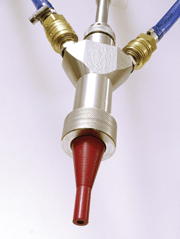E-Archive
Articles
in Vol. 10 - November Issue - Year 2009
A New Device for Blasting with CO2- Particles

Fig. 1: Prototype II of the new blasting device

Fig. 2: Blasting performance of the new prototype compared to the first prototype
Blasting with solid carbon dioxide has gathered more and more relevance over the last years. Whenever sensitive materials have to be cleaned or residues of cleaning agents cannot be tolerated this technology shows its great potential. Cleaning of vulcanizing moulds in the tire industry, pre-treatment of plastic parts before painting, maintenance of machines and production lines, the field of application is wide.
There are mainly two different process variants: dry ice blasting and CO2-blasting. For dry ice blasting CO2-particles are pressed into pellets that are accelerated by compressed air. Due to the hardness of these pellets and the relatively high kinetic energy the process is quite abrasive. It is used a lot in manual cleaning applications with gross soiling. The major disadvantages of this technology are the high air consumption and difficulties in automating the process because of the pellet generation step. Furthermore dry ice pellets are subliming continuously which puts high requirements on the logistics.
The second variant, CO2-snow blasting uses liquid carbon dioxide as a blasting agent. CO2-particles are generated in the blasting device by expanding the liquid gas. These particles are much smaller and softer compared to dry ice pellets and allow the cleaning of very sensitive surfaces. As liquid CO2 can be stored without any losses this technology is very suitable for automated cleaning processes or for occasional applications in workshops.
At the Institute for Machine Tools and Factory Management (IWF) of the Technical University Berlin a new device for blasting with CO2-particels was developed with several goals. First, the air consumption should be reduced to a minimum; while secondly, the abrasiveness of the system should be increased. Thirdly, the whole device should be as small as possible to allow the integration into existing machines and production lines. The problem was solved by the invention of a completely new functional principle, which was patented in Germany. Applications in several other countries are in preparation.
With the first prototype the feasibility of the principle could be proved but it showed an inhomogeneous cleaning capacity. Therefore berto product engineering in Graz, Austria was assigned to improve the existing system. After a development time of six months the new blasting device is now available for intensive testing. First trials showed a considerable improvement in homogeneity and abrasiveness compared to the first prototype (see fig. 2). At 8 bar blasting pressure 600 to 800 l compressed air per minute and 32 kg CO2 per hour are needed.
Ipal, the official patent agency of the Technical University Berlin is now looking for licensing partners for the commercialization of the blasting device. The patent exploitation agency assesses and markets the inventions of university scientists and academics on an exclusive basis. There is a wide range of application for the new prototype and it offers still great potentials for further developments, for example it is fully scalable and the nozzles themselves could be adapted to specific cleaning tasks. The new blasting device is a valuable completion in the field of CO2-cleaning which will help to gain new applications.
For Information: ipal GmbH
Intellectual Property Asset Management
Ralf Polaczek, Bundesallee 171
10715 Berlin, Germany
Tel. +49.0.30.2125.4820
Fax +49.0.30.2125.4822
E-mail: ralf.polaczek@ipal.de
www.ipal.de



























